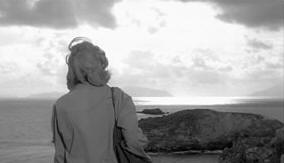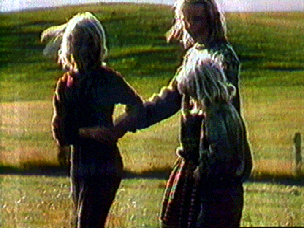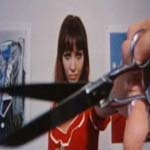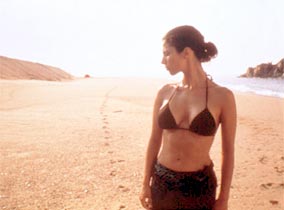



| Home | Schedule | Assignments | Grades | Conduct | Film Links |




To begin studying for this week's excerpted reading from Cinema 2: The Time-Image by Gilles Deleuze, review your Introduction to Film notes on Italian Neorealist, French New Wave, and European Art Cinemas. These post-World War II cinematic styles are intricately interwoven with Deleuze's theories about "the time-image."
Much of the cinema before World War II featured logical cause-and-effect narratives, their rational movement and space expressed via continuity editing. Deleuze studies this brand of cinema, with its emphasis on spatio-temporal and sensory-motor logic, in his book, Cinema 1: The Movement-Image.
In Cinema 2: The Time-Image, Deleuze analyzes shifts in the style and content of cinemas produced by filmmakers in direct response to the unstable epistemological climate of postwar Europe. This climate, as Ian Buchanan writes, is:
a world of rubble, housing shortages, refugees and bold reconstructions; it is clearly also a description of the present world. Deleuze also speaks of the cinematic or virtual worlds created in this period, signaling their radical difference in construction and operation from the cinema that preceded this moment.
The postwar setting, then, acts as the crucial rift in certain filmmakers' approaches to cinematic representation:
Why is the Second World War taken as a break? The fact is that, in Europe, the post-war period has greatly increased the situations which we no longer know how to react to, in spaces which we no longer know how to describe. These were ‘any spaces whatever’, deserted but inhabited, disused warehouses, waste ground, cities in the course of demolition or reconstruction. And in these any-spaces-whatever a new race of characters was stirring, a kind of mutant: they saw rather than acted, they were seers (FTC reader, 240).
It is important to stress that these any spaces whatever embody the epistemologically shaky ground of the era as much or more than the physical buildings in ruins themselves. Postwar filmmakers were both challenged and inspired when faced with their inability to describe these physical and psychological spaces concretely. As Deleuze concludes:
Precisely what brings this cinema of action [the pre-war cinema of the old realism] into question after the war is the very break-up of the sensor-motor schema: the rise of new situations to which one can no longer react, of environments with which there are now only chance relations, of empty or disconnected any-space-whatevers replacing qualified extended space (Cinema 2,272).
That is, instead of privileging rational representations of movement through the cause-and-effect logic of continuity editing, as is the predominant case for the movement-image of pre-war CHC and Tradition of Quality cinema, postwar filmmakers fashioned what Deleuze calls the time-image in order to undermine spatio-temporal logic. In effect, they reversed notions of rationality as engineered by classical cinema. They subordinated logical movement to the illogical, but ultimately more "realistic," representation of time itself--necessarily representing it in a more fractured state in order to reflect the epistemological anxieties of the postwar era.
The time-image is important because, as Deleuze says, "it makes us grasp something intolerable and unbearable ... something too powerful, or too unjust, but sometimes also too beautiful ... [or] too banal" (FTC reader, 264). Disjunctively "tearing" such a "real image" from the "clichés"--those established by the forced rational logic of the movement-image--means that we may better "produce a means of knowledge." It means that we may better understand our political climate beyond the clichés that have consumed our postwar world and the ease with which we think we understand it. Deleuze asserts that we
normally perceive only clichés. But, if our sensory-motor schemata jam or break, then a different type of image can appear: a pure optical-sound image, the whole image without metaphor, brings out the thing in itself, literally, in its excess of horror or beauty, in its radical or unjustifiable character, because it no longer has to be justified.... It is necessary to make a division or make emptiness in order to find the whole again (FTC reader, 266).
Deleuze looks to fragmentary montage to resist a cohesive logic when he theorizes a his concept of the irrational break. Specifically, he focuses on the “irrational cut between two images” as a means of creating disjunction and autonomy for both visual and sonic elements (pure optical and sound image, or opsign and sonsign). Deleuze pulls his terminology here from mathematics: the “irrational” cannot be classed within rational sets, and thus in cinema, the irrational cut lies outside the logic of the sets of shots it divides. Of course, the use of the term “irrational” is slippery since it readily slides into its more common connotation of illogicality, of lacking reason or sound judgment. Certainly, Deleuze is not arguing this angle, though his terminology invites misinterpretation.
Copyright: Dr. Virginia Bonner, Cinematic Caesuras, 2003.
Postwar Cinema: Italian Neorealism, French New Wave, European Art Film, New German Cinema, and some New Hollywood and American Independent Cinema of the 1970s
Postwar Crisis in Epistemology: the crisis in how Europeans understood and represented their world after World War II, resulting from the widespread fear that our ability to accurately know the world had been false, an illusion promoted by prewar faith in rationality.
Movement-Image: for our purposes also called "action-image" or "cinema of action," it's the style of "old realism" in much pre-war cinema that focuses on the rational linkages between situations and actions. Features continuity editing, cause-and-effect narrative logic, stable characters, etc.
Time-Image: made possible by the 5 characteristic preconditions annotated below, the time-image is the eruption of "the purely optical and sound situation which takes the place of the faltering sensory-motor situations" (the crisis of the old realism of the pre-war movement-image).
5 characteristic preconditions for
the time-image:
Note that these characteristics do not constitute the
time-image; they only make it possible.
Dispersed characters (multiple characters who are "seers" rather than "agents"; they can only see rather than act, record rather than react; all act in vain)
Dead-time narratives and Ellipses (weak connections, chance > cause & effect, indifference, banal or extreme events)
"Bal(l)ade" form (voyage, journey detached from cause & effect, aimless, placeless)
Multiplication of clichés (pastiche, postmodern awareness, challenge clichés to point of reflection)
Organization of misery (conspiracy)
Any Spaces Whatever: disconnected, emptied spaces as a result of the war & modern life
Irrational Cuts/Breaks: disjunctive editing to create autonomous moments in visual/sound relations, discontinuity, fragmentary & chopped-up realities
Dead Time: These moments occur when the image continues after narrative usefulness has ended, or when the people have left the frame [empty frames], leaving us with a non-anthropocentric image of the world. The “dead time” description is in at least one sense misleading. It is not time, or space, which is dead; these violent primordial forces are never more alive and devastating than at such moments, commenting on the modern, postwar human condition. (Adapted from Hamish Ford, "Antonioni's L'avventura and Deleuze's Time-image," in Senses of Cinema).